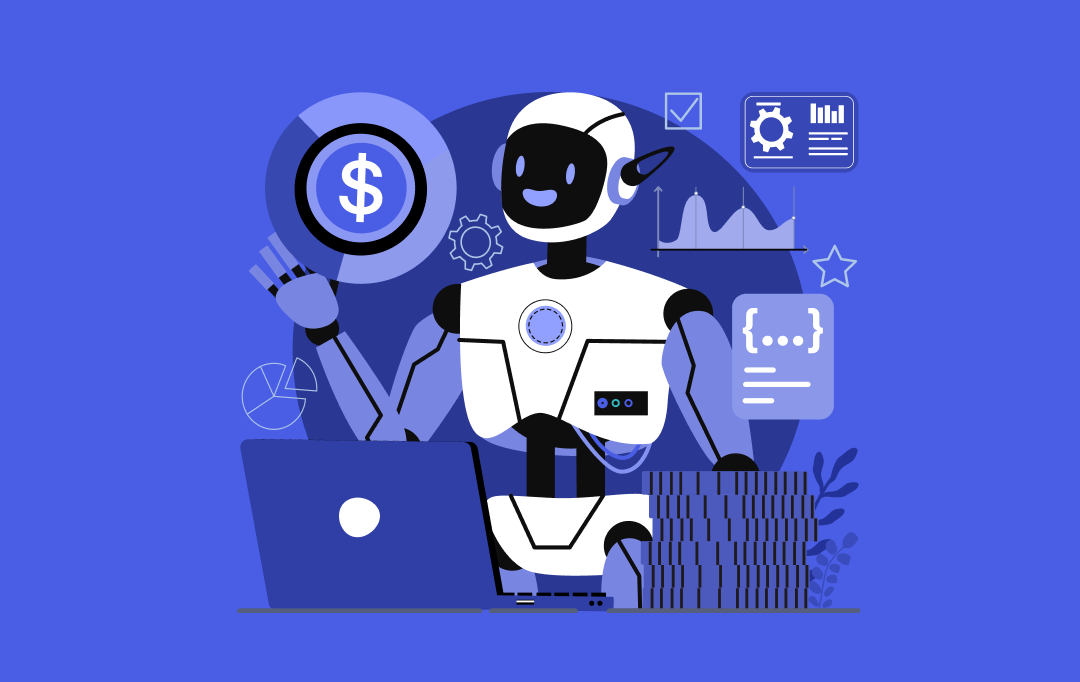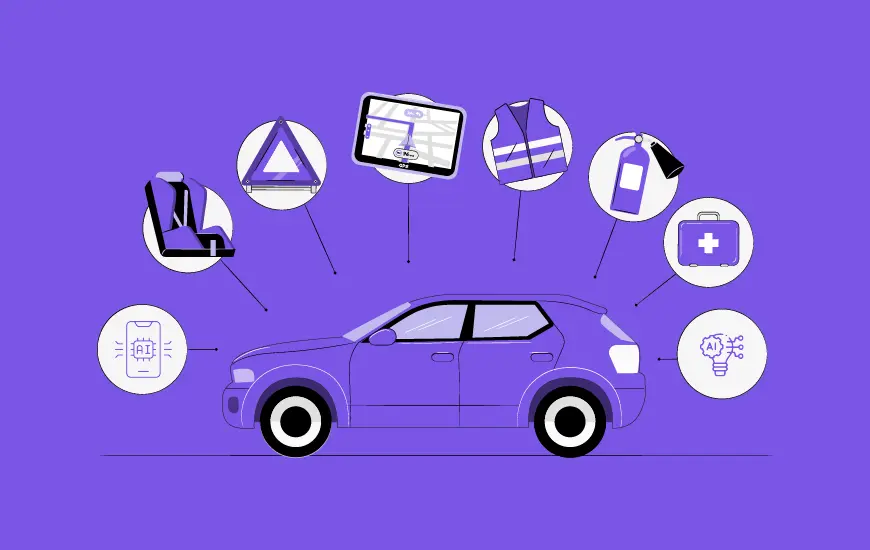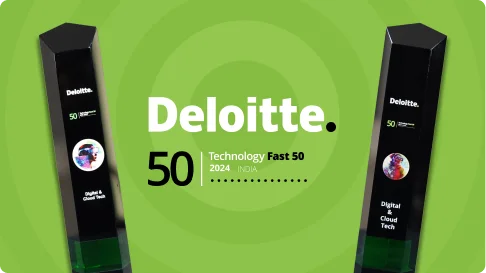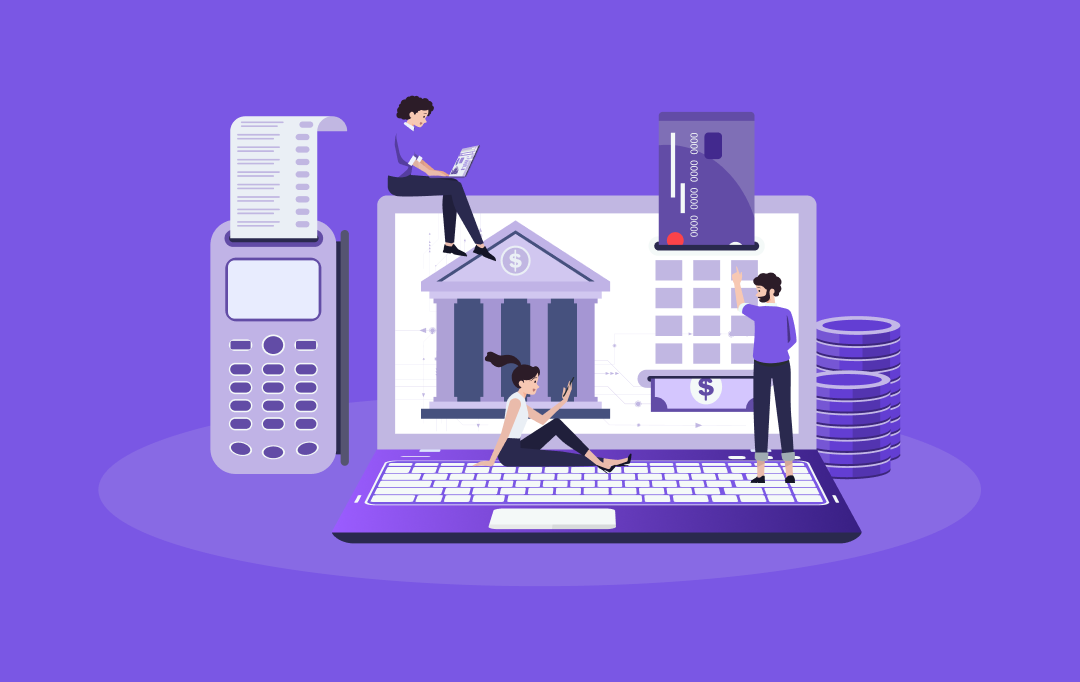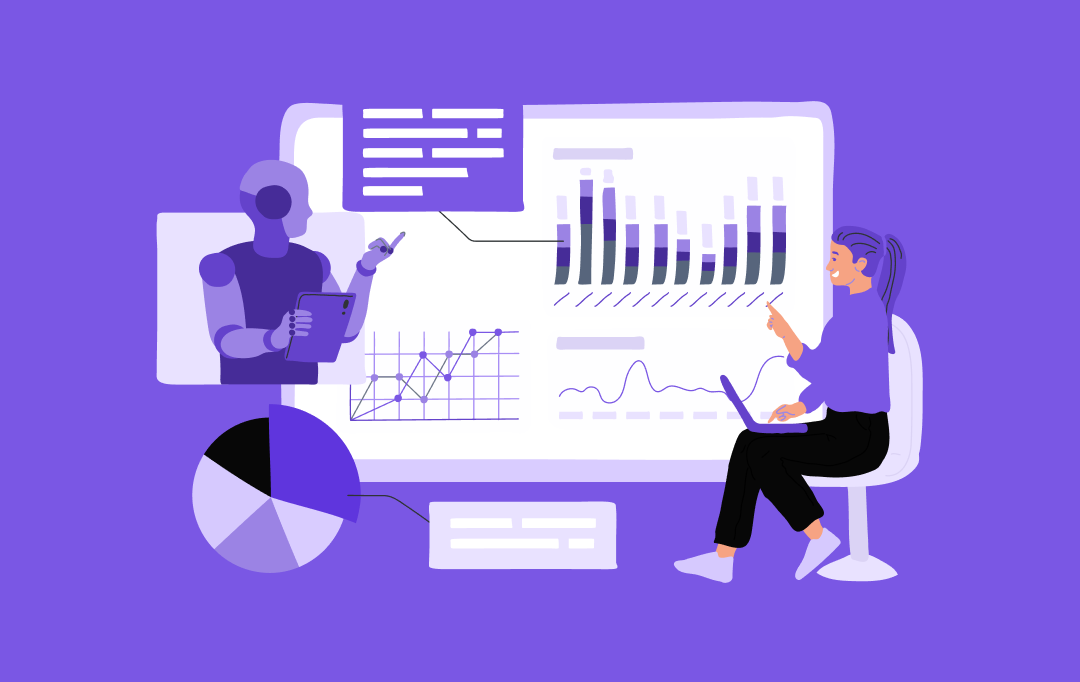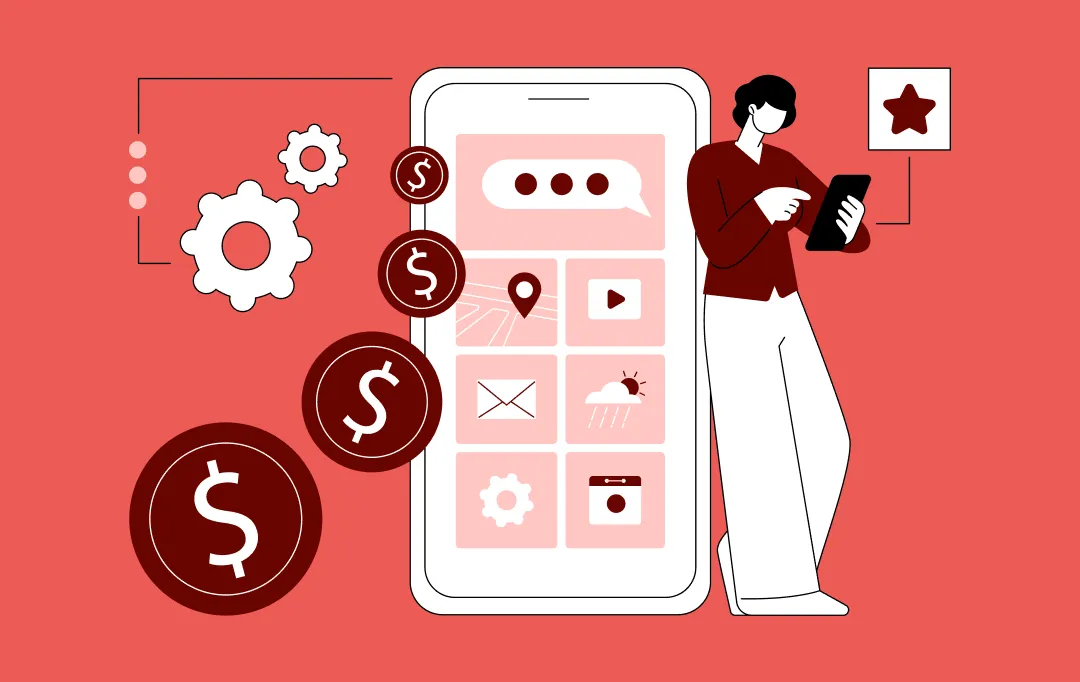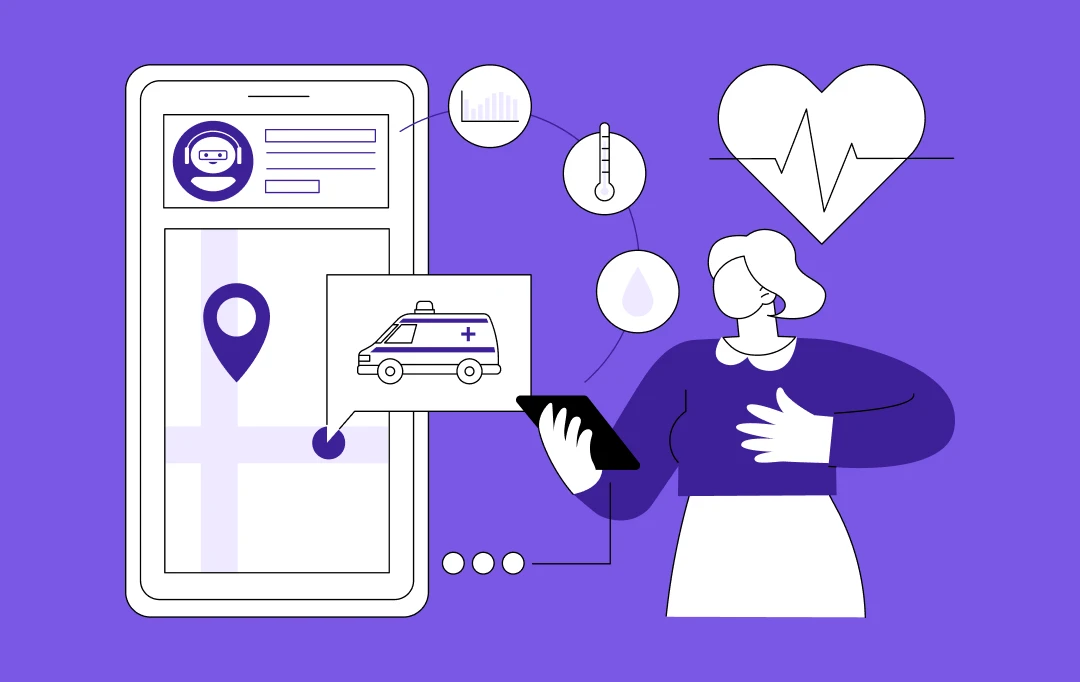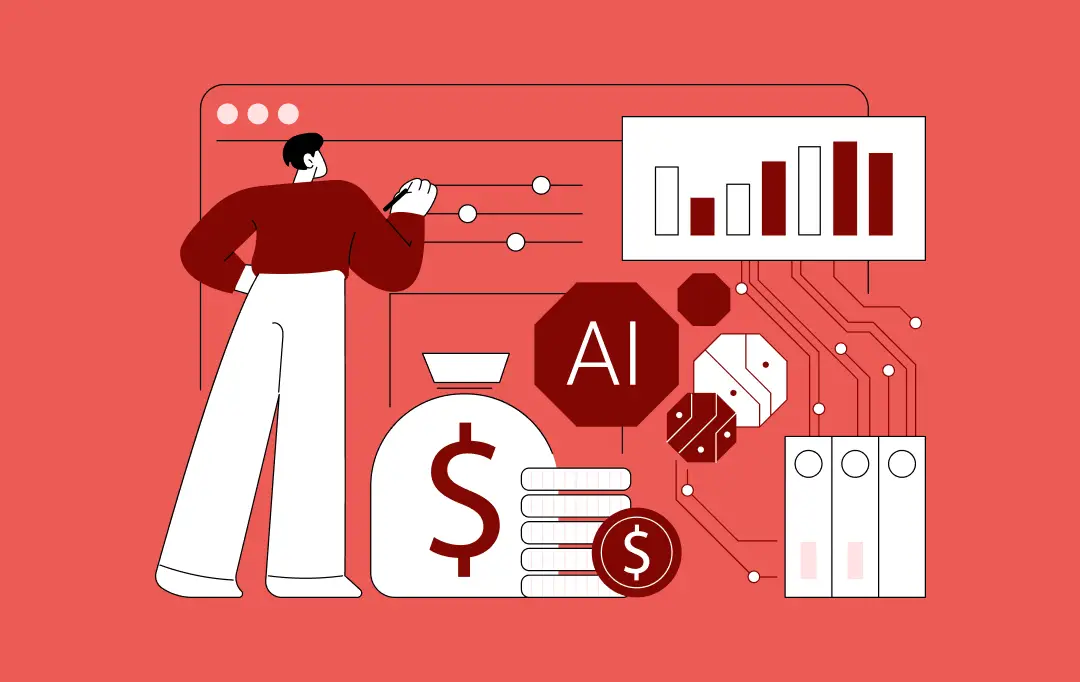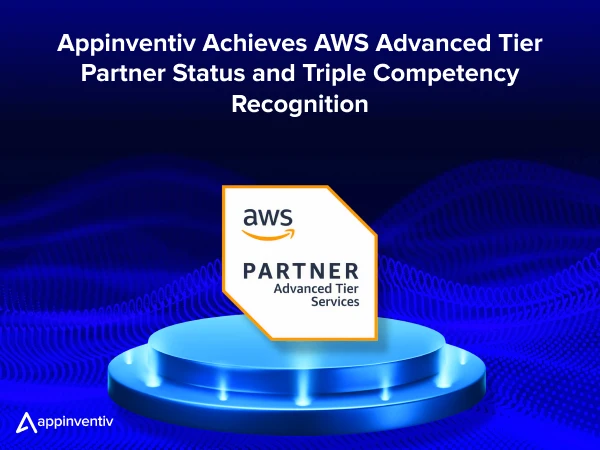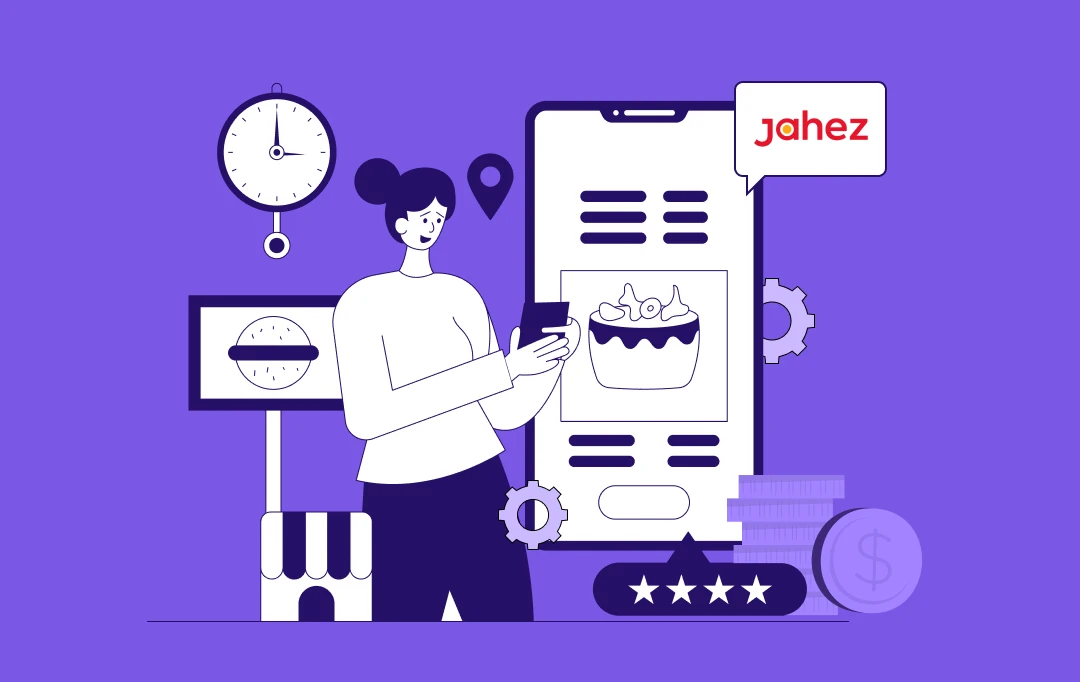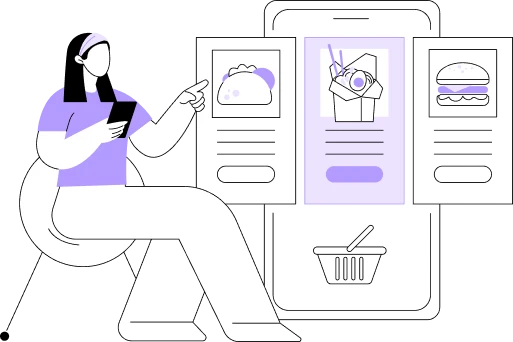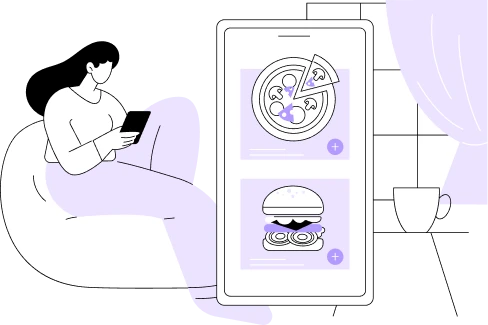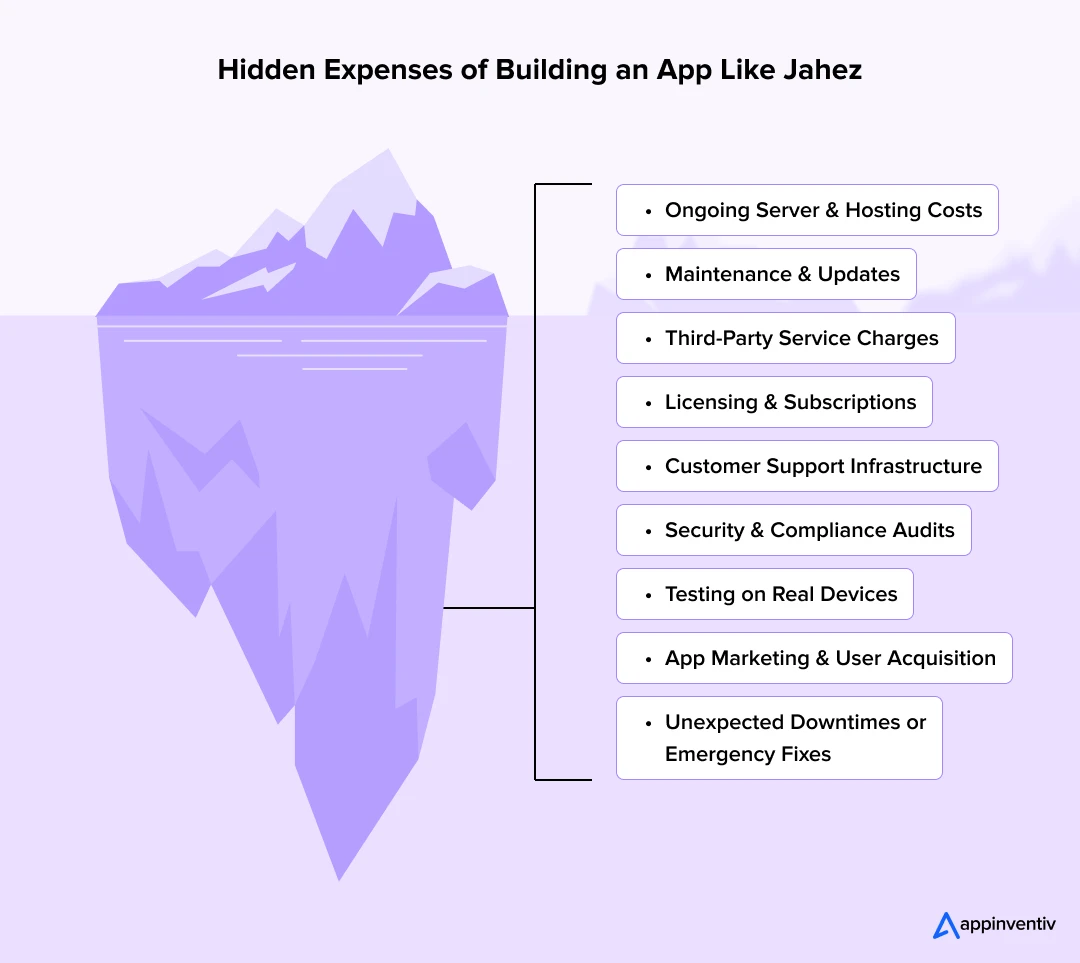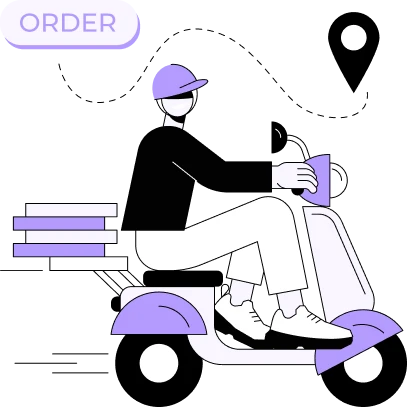- A Quick Overview of the Jahez Food Delivery App
- Key Jahez App Features:
- How Much Does it Cost to Build an App Like Jahez?
- Basic Food Delivery App
- Moderate Complexity Food Delivery App
- Advanced Food Delivery App
- Formula to Estimate Jahez Mobile App Development Cost
- Additional Considerations
- Factors Affecting the Cost of Developing an App Like Jahez
- 1. Complexity of Design
- 2. Feature Complexity
- 3. App Scalability
- 4. Customization Level
- 5. Third-Party Integrations
- 6. Security Measures
- 7. Compliance Measures
- 8. UI/UX Design
- 9. Multiple Platform Support
- 10. Technology Stack
- 11. Marketing and Launch Strategy
- Hidden Cost to Build an App Similar to Jahez
- App Store Fees
- Ongoing Server & Hosting Costs
- Maintenance & Updates
- Third-Party Service Charges
- Licensing & Subscriptions
- Customer Support Infrastructure
- Security & Compliance Audits
- Testing on Real Devices
- App Marketing & User Acquisition
- Unexpected Downtimes or Emergency Fixes
- Strategies to Optimize the Cost to Build An App Like Jahez
- 1. Prioritize Core Features
- 2. Lean Development Approach
- 3. Outsource Development
- 4. Utilize Open Source Tools
- 5. Cloud Services
- 6. Automate Testing
- 7. Effective Project Management
- Innovative Features to Make Your Food Delivery App Stand Out
- How to create a platform like Jahez
- How Do Food Delivery Apps Like Jahez Make Money?
- Why Appinventiv is the Right Development Partner for Developing a Food Delivery App Like Jahez
- 1. AI-Driven, Real-World Solutions for Maximum Efficiency
- 2. Proven Expertise with Industry Leaders
- 3. Localized for the Saudi Market
- FAQs
In the buzzing streets of Saudi Arabia, a quiet revolution is reshaping everyday life; the digital ease of food delivery apps like Jahez is replacing traditional dining. According to Statista, by 2029, over 19 million users are expected to order food through these platforms, signaling a dramatic shift in lifestyle and consumer habits.
This shift is driven by fast-paced urbanization, changing post-pandemic routines, and soaring smartphone usage. Mealtime has moved from the dinner table to the screen, where ordering anything from a sizzling shawarma to a gourmet burger is just a few taps away.
Leading this evolution are apps like Jahez, HungerStation, Talabat, and Daily Mealz, which have redefined convenience with user-first features tailored to the Saudi market. Their success story is more than inspiration; it signals to entrepreneurs that now is the time to make an app like Jahez.
Understanding what goes into making and funding such an app is crucial. The cost to build an app like Jahez could range from SAR 150,000 to over SAR 1,875,000 ($40,000 to a whopping $500,000+), with the final figure depending on the number of features you want and how big you plan to go.
In this blog, we’ll explain everything you need to know about starting a food delivery app like Jahez. We’ll talk about what features customers love, the challenges you might face, how much you need to spend, and most importantly, the Jahez like app development cost. Whether you’re a newcomer or a seasoned businessperson, getting the lowdown on how to break into and make it in Saudi Arabia’s digital food scene could turn your great idea into a successful business.
Ready to plate up your digital venture in a market hungry for innovation? Let’s explore how to slice through the competition and seize a piece of this billion-dollar pie.
A Quick Overview of the Jahez Food Delivery App
Jahez app development is among the most popular and most utilized food ordering applications in Saudi Arabia. It was released in 2016, and Jahez gained ground quickly by presenting a smooth, hassle-free experience perfectly suited to the Saudi market. The application allows the customer to be linked to different restaurants and local dining options, thus bringing ease of food ordering within the reach of customers with just a click.

What differentiates Jahez is its local-first strategy, intuitive interface, and intelligent logistics system, which guarantees on-time deliveries in the metropolitan cities and even the new areas of the Kingdom.
Key Jahez App Features:
- Localized Interface: Jahez has multi-language support (Arabic and English), guaranteeing it reaches an even larger audience.
- Real-Time Order Tracking: Customers can see in real-time orders being prepared and delivered to their doorstep.
- Large Restaurant Network: The application is associated with thousands of restaurants—local places and global fast-food chains—and offers customers ample dining options.
- Customizable Orders: The app lets users personalize their meals, include comments for special purposes, and quickly reorder past meals.
- Secure Payments: We accept various modes of payment, such as credit/debit cards, Apple Pay, and cash on delivery.
- Rating & Reviews: There is a platform where customers can leave reviews on restaurants and delivery staff, upholding quality and customer satisfaction.
- Promos & Discounts: Regular deals and offers keep users engaged and returning for more.
User-Side Features
- Quick registration via email, phone number, or social media
- Search and filter restaurants by cuisine, ratings, or proximity
- Real-time order status updates
- Secure and diverse payment integrations
- Reorder from past purchases
- Push notifications for order updates and offers
- In-app chat or call with delivery agents
- Ratings and feedback submission
Restaurant-Side Features
- Dashboard for managing incoming and completed orders
- Menu and price management
- Toggle dish availability in real-time
- Receive order alerts instantly
- Access to customer feedback and analytics
- Promotion and discount configuration
- Integration with existing POS systems
Delivery Personnel Features
- Instant alerts for new delivery assignments
- Navigation tools for route optimization
- Update delivery status (picked, on the way, delivered)
- Delivery history logs
- In-app communication with customers
- Wallet for tracking earnings and withdrawals
- Availability toggle to accept or decline deliveries
Admin-Side Features
- Full control over user, restaurant, and delivery agent accounts
- Set and manage commissions and payout cycles
- Data analytics and performance reports
- Manage platform-wide promotions and banners
- Monitor and resolve user disputes
- Content management system for app visuals and text
- Role-based access and permissions
- Security modules and fraud prevention mechanisms
Jahez app features have reshaped how people order food in Saudi Arabia and inspired a wave of app-based convenience services in the region. Its success is a good model for businesses looking to create a platform like Jahez in the Middle East.
How Much Does it Cost to Build an App Like Jahez?
Creating an app for ordering food, such as Jahez, involves a straightforward estimation of the expenses incurred, which differ based on the complexity level of the app and the feature set. Below is a breakdown of the cost to build an app like Jahez and timelines categorized by complexity levels:
Basic Food Delivery App
- Estimated Cost: SAR 37,500 – SAR 150,000 ($40,000 – $80,000)
- Key Features:
- User registration and login
- Restaurant listings
- Menu browsing
- Order placement
- Basic payment integration
- Development Timeline: Approximately 3 to 4 months
A basic app offers essential functionalities suitable for food delivery startups.
Moderate Complexity Food Delivery App
- Estimated Cost: SAR 150,500 – SAR 400,000 ($80,000 – $200,000)
- Key Features:
- All basic features
- User profiles
- Order tracking
- Push notifications
- Reviews and ratings
- Multiple payment options
- Admin panel for restaurant management
- Development Timeline: Approximately 4 to 6 months
This level caters to businesses aiming for a competitive edge with enhanced user engagement and management features.
Advanced Food Delivery App
- Estimated Cost: SAR 400,000 – SAR 1,100,000+ ($300,000 – $500,000+)
- Key Features:
- All moderate features
- Real-time GPS tracking
- AI-based recommendations
- Loyalty programs
- Social media integration
- Advanced analytics
- Customizable UI/UX
- Multi-language and currency support
- Development Timeline: Approximately 9 months or more
An advanced app is designed for enterprises seeking to dominate the market with a feature-rich, scalable solution.
Formula to Estimate Jahez Mobile App Development Cost
A general formula to estimate the Jahez application development cost is:
Total Development Cost = (Hourly Rate) x (Total Development Hours)
- Basic App: Approximately 480 hours
- Moderate App: Approximately 960 hours
- Advanced App: Approximately 1,440 hours
Note: Actual costs may vary based on the development team’s location and expertise.
Development Timelines Based on Complexity
- Basic App: 3 to 4 months
- Moderate App: 4 to 6 months
- Advanced App: 9 months or more
Timelines are approximate and can vary based on project scope and team efficiency.
Additional Considerations
- Platform Choice: Developing for iOS, Android, or both affects cost and time.
- Design Complexity: Custom designs increase development efforts.
- Third-Party Integrations: Incorporating services like payment gateways adds to the cost.
- Regulatory Compliance: This can involve the need to comply with domestic laws.
To make an app like Jahez, careful planning and clear definitions of requirements are essential for cost estimation and successful project execution.
Factors Affecting the Cost of Developing an App Like Jahez
Jahez like app development cost involves several components that directly influence the overall development cost. Here’s a closer look to the factors affecting the cost of developing an app like Jahez in detail:
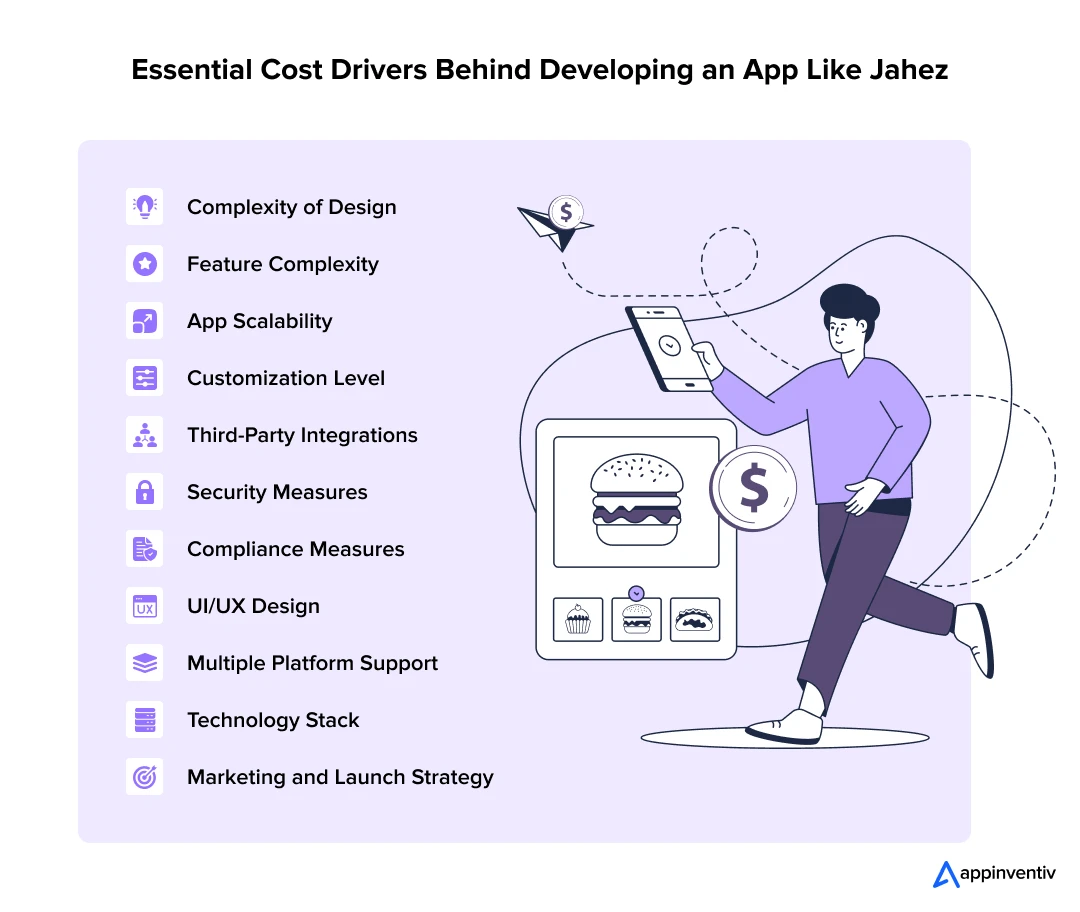
1. Complexity of Design
A simple layout with minimal visuals will cost far less than a dynamic interface with animations, micro-interactions, and personalized user journeys. Advanced design elements enhance the user experience but require more development hours.
2. Feature Complexity
The more features you add—like live GPS tracking, in-app chat, voice ordering, or AI-based recommendations—the higher the cost. Each feature increases development time, backend architecture, and testing efforts.
3. App Scalability
If developing a high-traffic-supported app for the future or current support of a high volume of users is the goal, the architecture must be scalable out of the gate—this adds expense but is a long-term success requirement.
4. Customization Level
Custom-built modules tailored for your brand or operations take more time and cost than ready-made or white-label solutions.
5. Third-Party Integrations
Payment gateway integrations (e.g., Stripe, PayPal), map integrations (Google Maps), CRM, or marketing software contribute to the expense based on complexity and licensing costs.
6. Security Measures
Data privacy is paramount, particularly for payment and personal information. Encryption, secure payment methods, GDPR compliance, and multi-factor authentication can increase development time and expense.
7. Compliance Measures
To operate legally in most regions, your app must comply with regional regulations (PCI-DSS for payments, GDPR for data, etc.). This requires expert consultation and technical implementation, adding to the budget.
8. UI/UX Design
A user-centered design makes for better engagement and loyalty, but UI/UX research, wireframing, prototyping, and user testing can make a big dent in both time and expense.
9. Multiple Platform Support
Developing natively for iOS and Android doubles your effort unless you use cross-platform technologies like Flutter or React Native, which still involve adaptation and testing.
10. Technology Stack
If you are wondering what the technology stack is for food delivery apps. Then, your tech stack—Node.js, React Native, Kotlin, Swift, Firebase, MongoDB—impacts development cost based on developer availability, licensing, and scalability needs.
11. Marketing and Launch Strategy
Beyond development, you’ll need to budget for pre-launch marketing, app store optimization (ASO), influencer partnerships, and possibly paid ads to get initial traction. A well-planned launch strategy is critical and needs to be allocated.
See how we jacked up KFC’s digital game with seven killer mobile apps worldwide. Let’s make your food app the next big thing.
Hidden Cost to Build an App Similar to Jahez
Beyond initial development, Jahez like app development cost in Saudi Arabia involves hidden expenses like app store fees, cloud hosting, and compliance audits. Startups aiming to make an app like Jahez should budget for ongoing maintenance (15–20% of initial costs annually).
The benefits of developing an app like Jahez, such as high ROI and brand loyalty, justify these investments, but meticulous planning ensures cost efficiency.
While estimating the cost to build an app like Jahez, several hidden or less obvious expenses can creep up during or after the project. Here’s what to keep in mind:
App Store Fees
Both the Apple App Store and Google Play charge developer fees. Apple requires an annual fee of SAR 370/year ($99/year), while Google Play charges a SAR 94 registration fee ($25 one-time).
Ongoing Server & Hosting Costs
Once your app is live, it needs cloud hosting to run smoothly. Costs depend on traffic, storage, and usage. Expect SAR 375 – SAR 1,875/month ($100 – $500/month) or more for scalable infrastructure (e.g., AWS, Google Cloud, or Azure).
Maintenance & Updates
Every app requires regular maintenance—bug fixes, OS updates, performance tuning, and new features. This typically costs 15–20% of the initial development cost annually.
Third-Party Service Charges
APIs and integrations (payment gateways, SMS services, maps, etc.) often have usage-based pricing. For instance:
- Twilio (SMS): ~SAR 0.028 per message (~$0.0075)
- Google Maps API: Charged per 1,000 requests
- Payment Gateways: ~2.9% + SAR 1.13 per transaction ($0.30)
Licensing & Subscriptions
You must include monthly or annual license fees for premium libraries, analytics software, or CMS platforms.
Customer Support Infrastructure
Setting up customer support—chatbots, call centers, ticketing systems—may require tools like Zendesk, Intercom, or Freshdesk, which cost SAR 187.5 – SAR 1,875/month ($50 – $500/month), depending on the scale.
Security & Compliance Audits
Periodic audits to stay compliant with standards like PCI-DSS, HIPAA, or GDPR (especially in international markets) can cost thousands, especially if external consultants are used.
Testing on Real Devices
Real device testing ensures a better user experience across all phone models. Using services like BrowserStack or owning devices adds cost.
App Marketing & User Acquisition
A major hidden cost! To get noticed in an oversaturated market, you’ll require a budget for:
- App Store Optimization (ASO)
- Paid Ads (Google, Facebook, TikTok)
- Influencer Marketing
Depending on your objectives, this can easily cost SAR 3,750 – SAR 37,500+ ($1,000 – $10,000+).
Unexpected Downtimes or Emergency Fixes
If the app crashes or experiences downtime, rapid-response developer support may be expensive, especially if you don’t have a support contract.
Strategies to Optimize the Cost to Build An App Like Jahez
Creating a successful app does not necessarily have to be expensive. With proper tactics, you can easily optimize the cost to build an app like Jahez.
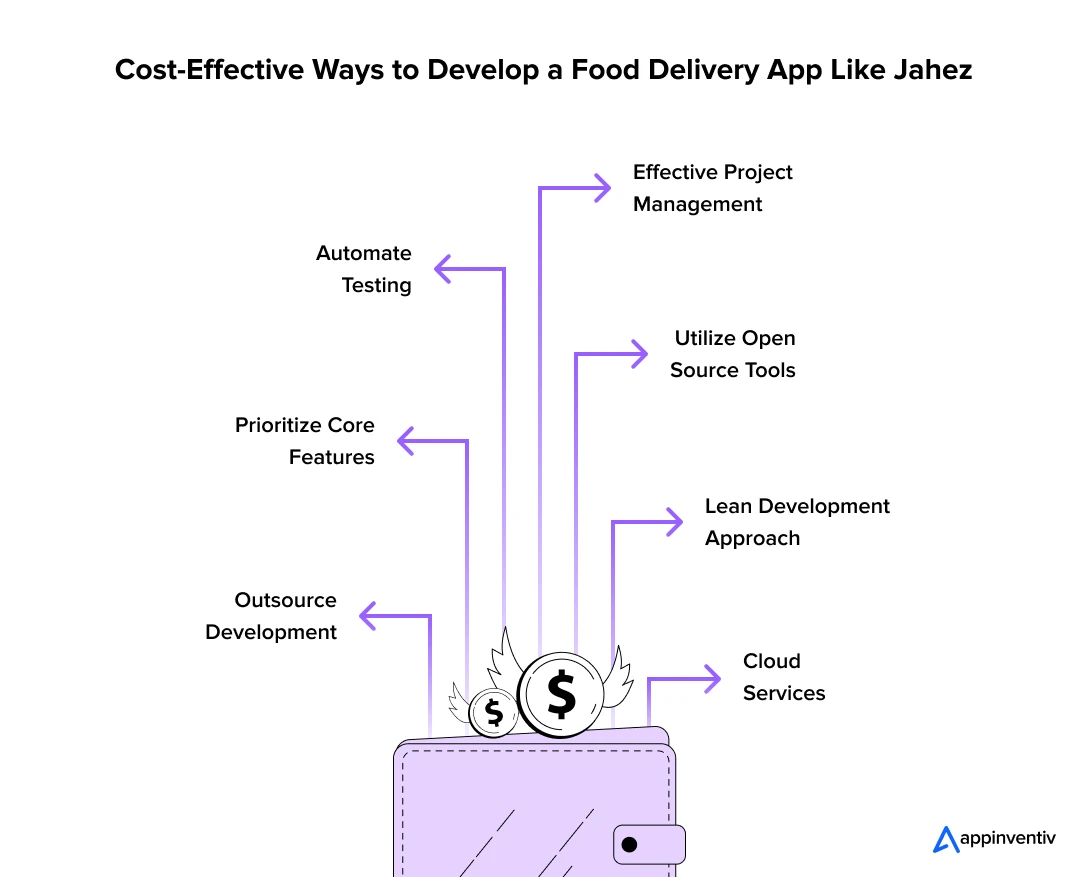
1. Prioritize Core Features
Prioritize going live with an MVP (Minimum Viable Product). Begin with core functionalities such as user registration, restaurant listing, placing orders, and payment integration. Later, as the app scales, add advanced features (like AI-based recommendations or loyalty programs).
2. Lean Development Approach
Follow an agile methodology, break development into sprints, test frequently, and iterate quickly. This reduces rework, ensures better feedback incorporation, and keeps the project on budget.
3. Outsource Development
Collaborating with seasoned offshore or nearshore development teams can save costs by as much as 40–60%, provided you’re aiming for nations such as India, Eastern Europe, or Southeast Asia without compromising quality.
4. Utilize Open Source Tools
Use open-source libraries and frameworks to reduce the cost of licensing. Tools like React Native or Flutter allow cross-platform app development in a cost-effective and time-saving way.
5. Cloud Services
Choose scalable cloud platforms such as AWS, Google Cloud, or Azure. They provide pay-as-you-go models that avoid upfront infrastructure expenses and enable you to scale up with demand.
6. Automate Testing
Employ automated testing tools to minimize manual QA hours. Tools such as Selenium, Appium, or TestComplete enable faster detection of bugs and enhanced release efficiency.
7. Effective Project Management
Utilize project management software such as Jira, Trello, or Asana to simplify communication, prevent delays, and keep developers in sync with the product vision. Clear documentation, set milestones, and frequent stand-ups eliminate expensive miscommunication.
Innovative Features to Make Your Food Delivery App Stand Out
Companies must look beyond the usual features to succeed in today’s competitive food delivery landscape. These are intelligent innovations that can differentiate your app:
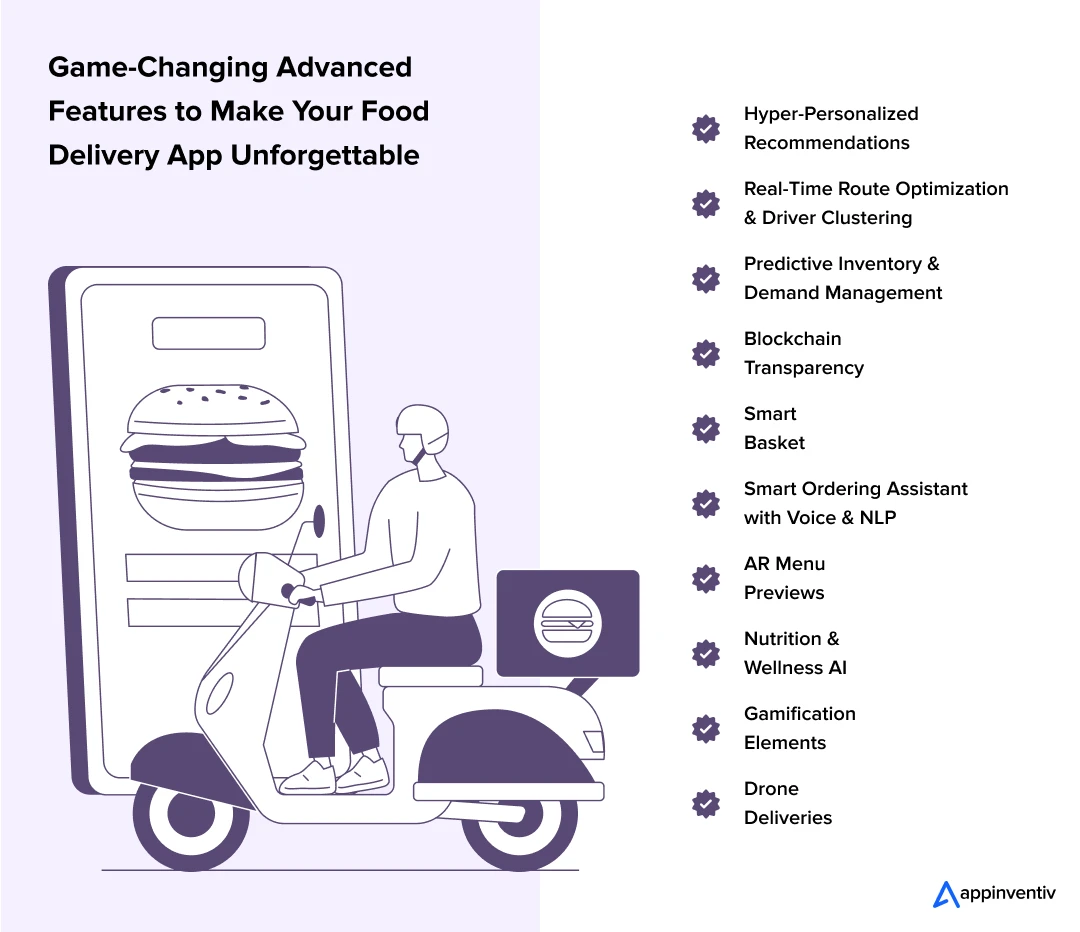
- Hyper-Personalized Recommendations: Use AI to recommend meals based on user activity, time, likes, and order history, providing an authentic personal experience.
- Smart Ordering Assistant with Voice & NLP: Allow users to make group or special orders through voice commands, which is faster and more convenient.
- Real-Time Route Optimization & Driver Clustering: Use AI to assign multiple nearby deliveries to the most efficient drivers, reducing wait times and fuel costs.
Bonus Read: Route Planner App Development Guide
- AR Menu Previews: Let users preview dishes in AR before ordering—boosting engagement and reducing order dissatisfaction.
- Predictive Inventory & Demand Management: Help restaurants plan better with AI that forecasts demand and manages stock, minimizing waste.
- Nutrition & Wellness AI: Offer nutrition insights, suggest healthier options, and align recommendations with fitness goals.
- Smart Basket: AI automatically recommends or fills in basket items based on past behavior or trending meals, simplifying choices and increasing cart value.
- Gamification Elements: To increase user engagement, add challenges, rewards, and leaderboards. Points from frequent orders can be redeemed for discounts, encouraging loyalty.
- Blockchain Transparency: Use blockchain to track food sourcing and delivery with full transparency, building trust and ensuring data integrity.
- Drone Deliveries: Leverage drones for quicker deliveries in congested areas, reducing time and operational costs.
How to create a platform like Jahez
Creating a successful food delivery app like Jahez requires a structured, step-by-step approach. Here’s a Jahez app development process:
 Conceptualization and Market Research: Identify your target audience, understand user pain points, and analyze competitor apps to define your unique value proposition.
Conceptualization and Market Research: Identify your target audience, understand user pain points, and analyze competitor apps to define your unique value proposition.
Planning and Strategy Development: Map core features, tech stack, development timelines, and budget. Set clear goals for MVP and scalability options.
UX/UI Design: Design an intuitive and user-friendly interface that reflects your brand while providing a seamless experience to all users.
Technical Architecture and Backend Development: Develop a scalable, secure infrastructure that enables user management, order processing, payments, and real-time data.
Frontend Development: Implement UI designs into functional interfaces on all platforms (iOS, Android, web) with responsive design principles.
Third-Party Services Integration: Add APIs for payment gateways, GPS tracking, restaurant databases, SMS/email notifications, and analytics.
Quality Assurance and Testing: Conduct stringent testing—unit, performance, security, and usability—to maintain stability, speed, and safety.
Deployment: Publish the app on corresponding app stores (Google Play, App Store) with configurations, metadata, and compliance validation.
Post-Launch Support and Maintenance: Track app performance, address bugs, release updates, and collect user feedback for ongoing improvement.
How Do Food Delivery Apps Like Jahez Make Money?
Food delivery apps such as Jahez employ several revenue streams to support and grow their business:
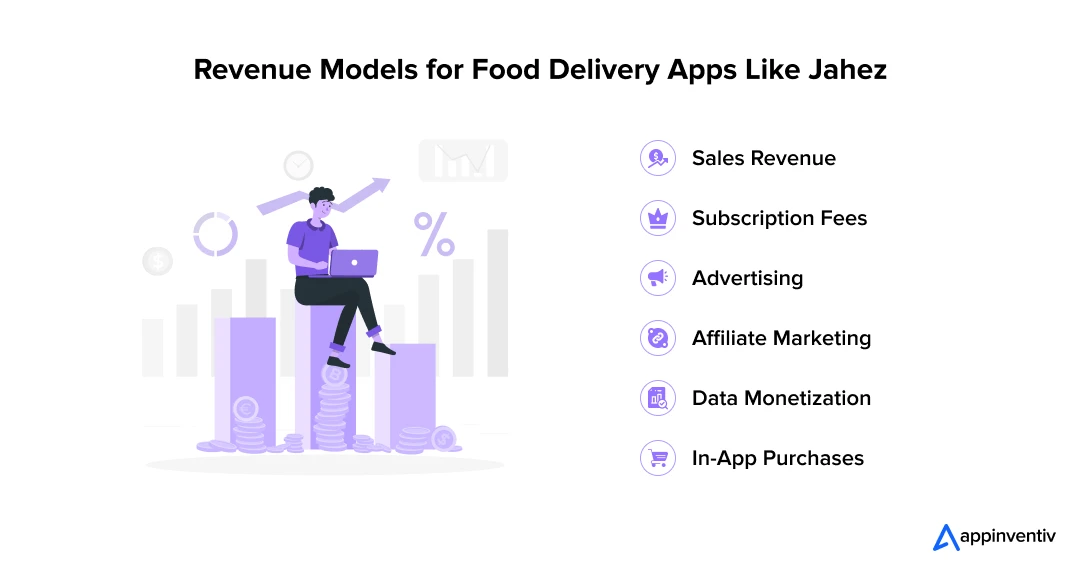 Sales Revenue: A percentage-based commission is charged on each order made through the app, usually taken from partner restaurants.
Sales Revenue: A percentage-based commission is charged on each order made through the app, usually taken from partner restaurants.
Subscription Fees: Some platforms have loyalty programs or premium subscriptions with perks such as free delivery, special deals, or quicker service.
Advertising: Restaurants pay to advertise their listings or show banner ads within the app, driving visibility and orders.
Affiliate Marketing: Income comes from advertising third-party services such as payment gateways, ride-sharing, or grocery platforms.
Data Monetization: User data can be analyzed and sold (ethically and legally) to partners for business intelligence or market research.
In-App Purchases: Users may pay for add-ons like extra sauces, premium packaging, or donation options, adding a micro-revenue stream.
Why Appinventiv is the Right Development Partner for Developing a Food Delivery App Like Jahez
Launching a successful food delivery app like Jahez in Saudi Arabia requires more than technical expertise; it demands a partner with deep market insight, innovative solutions, and a proven track record. At Appinventiv, our expertise ensures transparent Jahez like app development cost estimates and scalable architectures. A Custom Mobile app development company in Saudi Arabia is ideal, combining cutting-edge technology with a strategic understanding of the Saudi market.
1. AI-Driven, Real-World Solutions for Maximum Efficiency
Appinventiv goes beyond basic app development by integrating AI, IoT, and real-time analytics to create smarter, more efficient food delivery platforms. Imagine an app that:
- Predicts customer preferences for personalized recommendations.
- Optimizes delivery routes dynamically to reduce wait times.
- Supports secure, multi-payment options tailored for Saudi users.
This isn’t about flashy features—it’s about enhancing user experience and operational performance in ways that directly impact your bottom line.
2. Proven Expertise with Industry Leaders
Appinventiv’s credibility is backed by its work with global giants like KFC and Domino’s, where we’ve built solutions focused on boosting engagement and streamlining operations. The portfolio showcases:
- Scalable, high-performance apps designed for heavy user traffic.
- Seamless integration with restaurant management systems.
- Data-driven optimizations to improve customer retention.
Explore these case studies to see how we’ve solved real challenges in food tech.
3. Localized for the Saudi Market
Success in Saudi Arabia hinges on understanding local preferences, cultural nuances, and regulatory requirements. Appinventiv designs apps with:
- Arabic-language support and right-to-left (RTL) UI/UX.
- Compliance with Saudi data and payment laws (e.g., SAMA regulations).
- Hyperlocal marketing strategies to drive user adoption.
Choosing Appinventiv means partnering with a team that delivers innovation, scalability, and market-specific expertise, all critical for dominating Saudi Arabia’s competitive food delivery landscape.
Ready to build an app that stands out? Get in touch with Appinventiv today.
FAQs
Q. How long does it take to build a food delivery app like Jahez?
A. Depending on its complexity, a simple app will take 3–4 months, and a fully featured one 6–9 months or more.
Q. How to develop an app like Jahez in Saudi Arabia?
A. To develop an app like Jahez:
- Research: Study Saudi Arabia’s $8.8B food delivery market and competitors.
- Features: Include order placement, real-time tracking, payments, and Arabic/English UI.
- Tech: Use React Native, Node.js, and Google Maps API.
- Team: Hire 2–3 developers, a UI/UX designer, and a QA tester.
- Compliance: Follow Saudi data privacy and Vision 2030 regulations.
- Launch: Test beta in Riyadh/Jeddah, partner with restaurants, and market via social media.
- Support: Offer updates and customer service. Consult local food delivery app developers like Appinventiv for expertise.
Q. How much does it cost to create a food delivery app in Saudi Arabia?
A. The cost to build a food delivery app in Saudi Arabia is based on its complexity levels and the number of features added. Jahez like app development cost structure includes:
- Basic: $25K–$40K
- Moderate: $40K–$70K
- Advanced: $70K–$120K+
Costs vary based on features, tech stack, and design.
Q. How can I reduce the cost to build an app like Jahez?
A. To lower the Jahez mobile app development cost:
- Start with a Minimum Viable Product (MVP) focusing on core features like ordering and payments.
- Use cross-platform frameworks like Flutter or React Native to target both iOS and Android.
- Opt for pre-built templates or APIs for features like maps or payments.
- Hire developers from cost-effective regions or outsource to reliable agencies.
- Plan thoroughly to avoid costly redesigns or feature additions later.
Q. How do apps like Jahez in Saudi Arabia earn money?
A. Revenue comes from commissions, subscriptions, ads, affiliate marketing, and in-app purchases.
Q. How long does a Jahez like app development in Saudi Arabia take?
A. The timeline for a Jahez like app development in Saudi Arabia depends on the project scope. A minimum viable product (MVP) can take 3–6 months, while a fully featured app with custom designs and integrations may require 8–12 months or more.


- In just 2 mins you will get a response
- Your idea is 100% protected by our Non Disclosure Agreement.

How Much Does It Cost to Build a Car Rental App like Hertz?
Key takeaways: The cost to build a Hertz-like app ranges roughly $40,000–$300,000+. Complexity, automation, and scale matter more than just the number of features. Real costs continue after launch: infra, maintenance, support, and compliance. Smart planning and MVP-first approach help keep budgets under control. Revenue comes from rentals, add-ons, subscriptions, partnerships, and fleet sales. You…
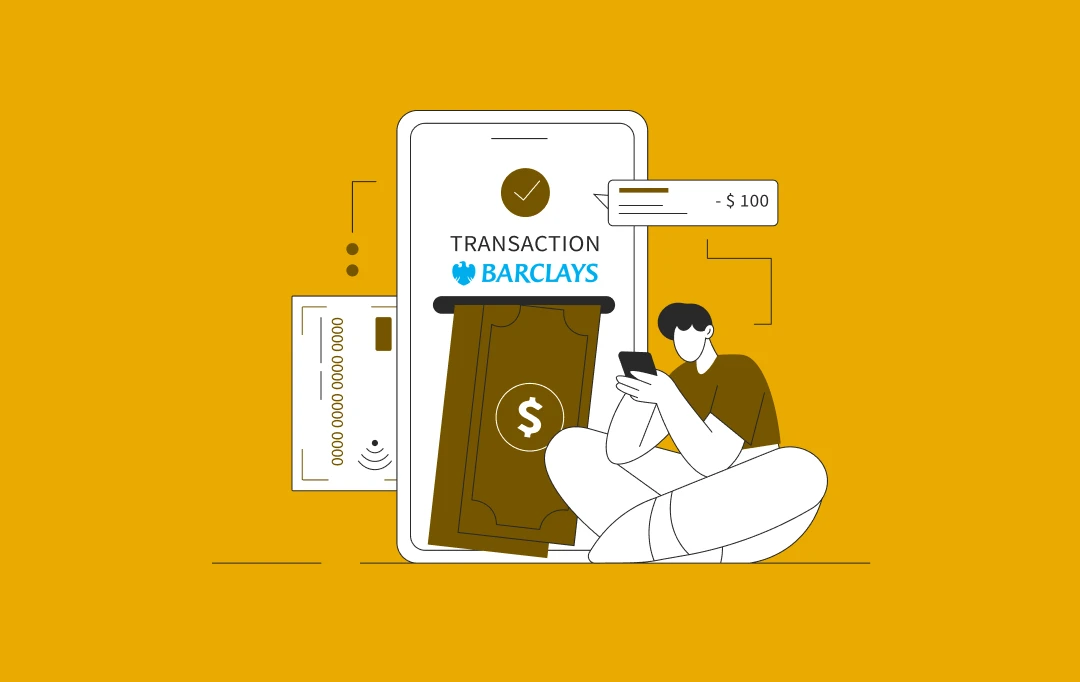
How Much Does It Cost to Build a Banking App like Barclays?
Key takeaways: Barclays sets the bar: Its speed, security, and money management tools show what EU users expect from modern banking apps. Costs vary a lot: A basic, compliant app can start around $40,000 (≈€30,000), while a feature-rich build can reach $400,000+ or more (≈€298,000+). Rules add real work: Meeting PSD2, GDPR, and instant payment…
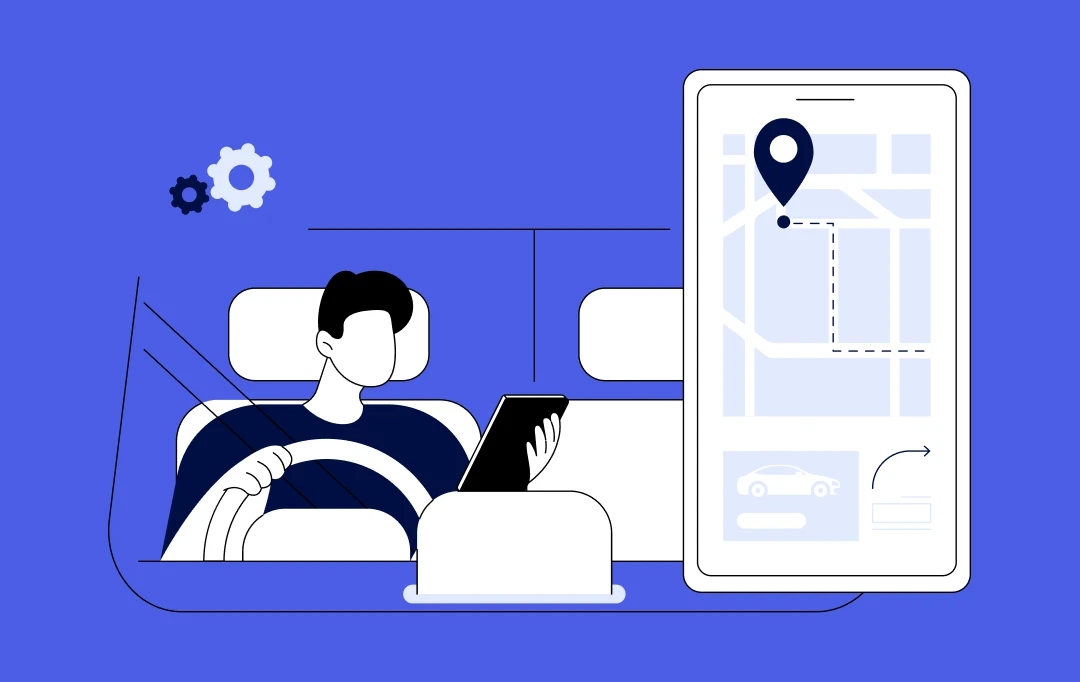
How Much Does It Cost to Build a Route Planning App Like Komoot
Europe doesn’t just love the outdoors- it thrives on it. From the Alps to Amsterdam’s bike lanes, cycling and hiking fuel an industry worth $53.3 billion in 2024, projected to grow at nearly 11% CAGR through 2033, as reported by GrandViewResearch. And leading this charge is Komoot, the route-planning app trusted by 40+ million users.…
